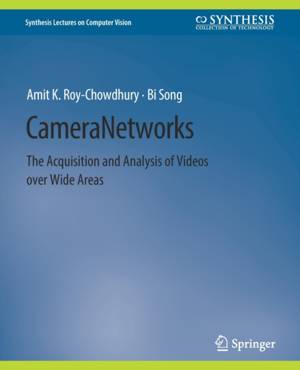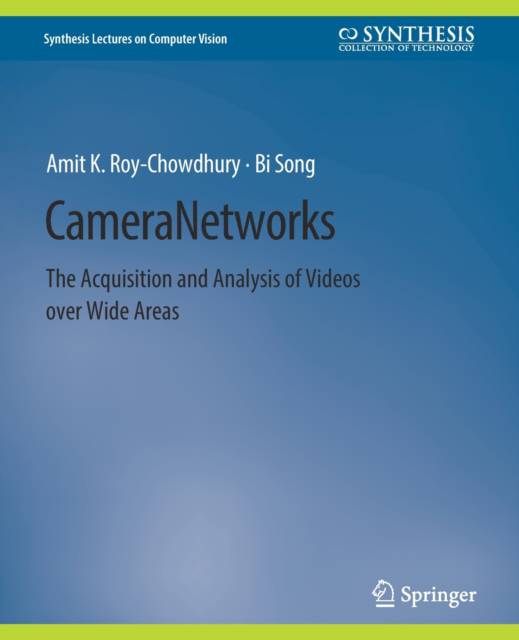
En raison d'une grêve chez bpost, votre commande pourrait être retardée. Vous avez besoin d’un livre rapidement ? Nos magasins vous accueillent à bras ouverts !
- Retrait gratuit dans votre magasin Club
- 7.000.000 titres dans notre catalogue
- Payer en toute sécurité
- Toujours un magasin près de chez vous
En raison de la grêve chez bpost, votre commande pourrait être retardée. Vous avez besoin d’un livre rapidement ? Nos magasins vous accueillent à bras ouverts !
- Retrait gratuit dans votre magasin Club
- 7.000.0000 titres dans notre catalogue
- Payer en toute sécurité
- Toujours un magasin près de chez vous
Camera Networks
The Acquisition and Analysis of Videos Over Wide Areas
Amit K Roy-Chowdhury, Bi Song
34,95 €
+ 69 points
Format
Description
As networks of video cameras are installed in many applications like security and surveillance, environmental monitoring, disaster response, and assisted living facilities, among others, image understanding in camera networks is becoming an important area of research and technology development. There are many challenges that need to be addressed in the process. Some of them are listed below: - Traditional computer vision challenges in tracking and recognition, robustness to pose, illumination, occlusion, clutter, recognition of objects, and activities; - Aggregating local information for wide area scene understanding, like obtaining stable, long-term tracks of objects; - Positioning of the cameras and dynamic control of pan-tilt-zoom (PTZ) cameras for optimal sensing; - Distributed processing and scene analysis algorithms; - Resource constraints imposed by different applications like security and surveillance, environmental monitoring, disaster response, assisted living facilities, etc. In this book, we focus on the basic research problems in camera networks, review the current state-of-the-art and present a detailed description of some of the recently developed methodologies. The major underlying theme in all the work presented is to take a network-centric view whereby the overall decisions are made at the network level. This is sometimes achieved by accumulating all the data at a central server, while at other times by exchanging decisions made by individual cameras based on their locally sensed data. Chapter One starts with an overview of the problems in camera networks and the major research directions. Some of the currently available experimental testbeds are also discussed here. One of the fundamental tasks in the analysis of dynamic scenes is to track objects. Since camera networks cover a large area, the systems need to be able to track over such wide areas where there could be both overlapping and non-overlapping fields of view of the cameras, as addressedin Chapter Two: Distributed processing is another challenge in camera networks and recent methods have shown how to do tracking, pose estimation and calibration in a distributed environment. Consensus algorithms that enable these tasks are described in Chapter Three. Chapter Four summarizes a few approaches on object and activity recognition in both distributed and centralized camera network environments. All these methods have focused primarily on the analysis side given that images are being obtained by the cameras. Efficient utilization of such networks often calls for active sensing, whereby the acquisition and analysis phases are closely linked. We discuss this issue in detail in Chapter Five and show how collaborative and opportunistic sensing in a camera network can be achieved. Finally, Chapter Six concludes the book by highlighting the major directions for future research. Table of Contents: An Introduction to Camera Networks / Wide-Area Tracking / Distributed Processing in Camera Networks / Object and Activity Recognition / Active Sensing / Future Research Directions
Spécifications
Parties prenantes
- Auteur(s) :
- Editeur:
Contenu
- Nombre de pages :
- 119
- Langue:
- Anglais
- Collection :
Caractéristiques
- EAN:
- 9783031006838
- Date de parution :
- 27-01-12
- Format:
- Livre broché
- Format numérique:
- Trade paperback (VS)
- Dimensions :
- 190 mm x 235 mm
- Poids :
- 244 g

Les avis
Nous publions uniquement les avis qui respectent les conditions requises. Consultez nos conditions pour les avis.






